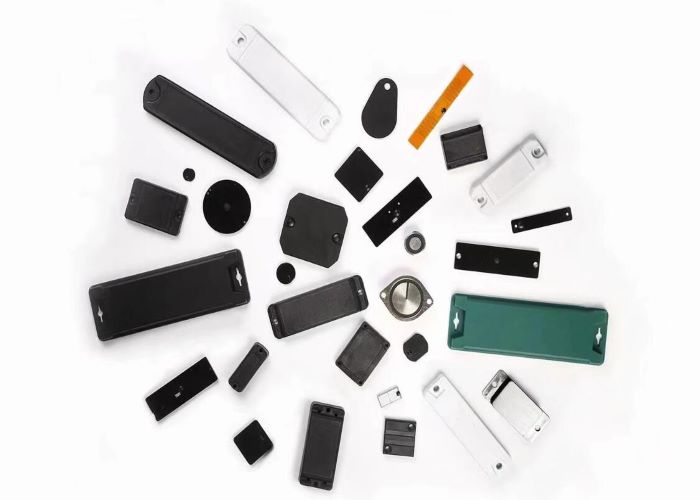400-9920-618
In recent years, due to the continuous deepening of people's cognition of RFID technology and the continuous reduction of application costs, RFID has continued to accelerate its penetration in all walks of life. For example, the clothing industry, library book management, airport logistics sorting, airline luggage tracking, etc. all use RFID technology solutions. The most commonly used tags in RFID technology can be divided into low-frequency RFID tags, high-frequency RFID tags and ultra-high-frequency RFID electronic tags. And UHF RFID tags and UHF rfid reader devices are widely used because they can recognize high-speed moving objects, realize simultaneous recognition of multiple objects, reusable, large data memory etc.
In diversified application scenarios, there are rich label types.
Since different industries and application scenarios have significant differences in requirements and usage conditions,which put forward for the performance and shape of labels. This is mainly based on the balance of business requirements, process conditions, application costs, application scenario environment, etc. For example, if the identified object is a metal product, it is necessary to add absorbing materials to achieve metal-resistant properties.
Electronic label products can be roughly divided into three categories in terms of modality, include traditional self-adhesive labels, injection-molded labels and card labels. The traditional RFID electronic label encapsulates the RFID chip into a self-adhesive form, which is suitable for use in scenarios such as highways, parking lots and automatic collection of product information in industrial production lines. And non-contact IC cards are often used in campus, traffic, access control and other scenarios etc , and it is easy to see special-shaped labels made by injection molding in access control.
In addition, because different countries and regions have different spectrum allocation, the coverage of UHF RFID frequency band definitions is also different, for example:
(1) The frequency bands in China are: 840~844MHz and 920~924MHz;
(2) The EU frequency band is: 865MHz~868MHz;
(3) The frequency band in Japan is: between 952MHz and 954MHz;
(4) Hong Kong, Thailand and Singapore are: 920MHz~925MHz;
(5) The frequency bands of the United States, Canada, Puerto Rico, Mexico, and South America are: 902MHz~928MHz.
Common applications and label forms of UHF RFID

(1) Coated paper label/woven label in shoes and apparel retail industry
RFID tags are commonly used in the footwear and apparel industry, which is also one of the areas with the largest consumption of UHF RFID tags.
The introduction of RFID technology in the footwear and apparel industry is a whole process, from factories to warehouses to retail terminals. It can automatically collect the data of each operation link such as arrival inspection, warehousing, allocation, warehouse shifting, inventory counting, etc. So as to ensure the speed and accuracy of data input in all aspects of warehouse management, and ensure that the enterprise timely and accurate grasp of the real data of inventory, reasonable maintenance and control of enterprise inventory. In the case of a global sales layout, fashionable FMCGs have high requirements on the liquidity of goods, and the use of RFID tags can greatly improve the efficiency of product circulation management.
(2) Ceramic electronic label
Ceramic electronic tags are encapsulated electronic tags that based on ceramic materials, with high electrical characteristics and high performance resistance, fragile and anti-transfer. The electronic tag antenna installed on the ceramic substrate has small dielectric loss, good high-level characteristics, stable antenna performance and high sensitivity. It is mostly used in logistics warehousing, intelligent parking, production line management, anti-counterfeiting detection and other fields.
(3) ABS label
ABS labels are common injection-molded labels that are often used in logistics management scenarios. It can be installed on the surface of metal, wall, wood products and plastic products. Due to the strong protective function of the surface layer, it is resistant to high temperature and moisture, suitable for harsh working environments.
(4) Silicone Labels for Garment Washing
Silicone labels use silicone packaging technology and are mostly used in the washing industry. Because silicone is soft and deformable, and has the characteristics of high temperature resistance and rubbing resistance, it is often used for inventory management of towels and clothing products.
(5) Cable tie label
Cable tie labels are generally packaged with PP+ nylon materials, which have excellent characteristics such as easy installation and disassembly, waterproof, and high temperature resistance. They are often used in logistics tracking, food traceability, asset management and other fields.
(6) Epoxy PVC card label
The card made of PVC material can be customized according to the shape, so that the card has the appearance and texture of handicrafts, and it can effectively protect the internal chip and antenna, and it is convenient to carry. It can be used for access control, item identification management, game chips and other scenarios.
(7)PET label
PET is the abbreviation of polyester film, and polyester film is a kind of polymer plastic film, which is more and more favored by consumers because of its excellent comprehensive performance. It can block ultraviolet rays, has good high and low temperature resistance, and has good creep resistance. PET labels are often used in jewelry management scenarios.
(8)PPS laundry label
PPS laundry tag is a common type of RFID tag in the linen washing industry. It is similar in shape and size to buttons and has strong temperature resistance. Washing management becomes more efficient and transparent by using PPS laundry labels.
Handheld-Wireless has been deeply engaged in the R&D and production of RFID equipment for more than ten years, and can provide various UHF tags, RFID readers, handhelds and customized solutions.